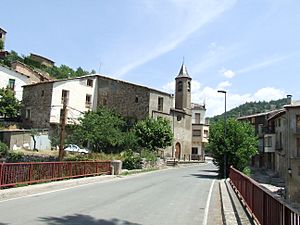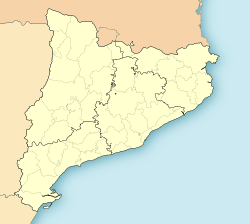Senterada facts for kids
Quick facts for kids
Senterada
|
|||
|---|---|---|---|
|
Municipality
|
|||

Centre of Senterada
|
|||
|
|||
| Country | |||
| Community | |||
| Province | |||
| Comarca | Pallars Jussà | ||
| Area | |||
| • Total | 34.4 km2 (13.3 sq mi) | ||
| Population
(2018)
|
|||
| • Total | 139 | ||
| • Density | 4.041/km2 (10.47/sq mi) | ||
Senterada (pronounced sen-teh-RAH-tha) is a small village in the Lleida province of Catalonia, Spain. It's a part of the Pallars Jussà area. This municipality even includes a small piece of land separate from the main area, located to its north.
Contents
A Look Back in Time: Senterada's History
Senterada has a long and interesting history. People lived here even in prehistoric times! We know this because of ancient stone structures called dolmens. These include the dolmens of Casa Encantada, Mas Pallarès, Sant Roc, and Cabaneta del Moro. Another one is the Cabana del Moro in Reguard.
How Senterada Began
The village of Senterada likely grew around an old monastery called Santa Grata. This monastery was built by the Visigoths, an ancient people who lived in Spain. When the monastery was no longer used, its church became the main church for the growing village. Senterada was also a good place for a town because important travel routes crossed here. Plus, it was where the Bòssia and Flamisell rivers met. This helped the town grow.
Senterada Through the Centuries
In 1381, Senterada was mentioned as part of the Bellera barony. A barony was an area ruled by a baron. In 1553, the village experienced five fires. By 1718, Senterada, along with the rest of the Bellera barony, was owned by the barons of Sant Vicenç and the Dukes of Cardona. Later, in 1831, the Marquis of La Manresana owned the village. The nearby town of Larén is often mentioned alongside Senterada in old records.
Life in Senterada in the 1800s
A book from 1845, called Diccionario geográfico by Pascual Madoz, describes Senterada. It says the village had a healthy climate. It was located in a valley where two rivers met to form the Flamisell River. A mountain protected it from cold north winds. Madoz noted there were 12 houses in the village. The land was rough and not very fertile. People mostly grew wheat, rye, and barley. There was also a gypsum mine. Villagers could catch trout and barbel in the rivers. There were three looms for weaving cloth and a place to wash clothes. At that time, Senterada had 6 families and 51 people living there.
Senterada in the Early 1900s
Around 1900, Senterada had 265 buildings. The total population was about 466 people. In Senterada village itself, there were 54 houses with 126 people. At this time, the village had a school for both boys and girls. Children of different ages shared the same classroom.
How Many People Lived Here? Senterada's Population
Here's a look at how the number of people living in Senterada changed over many years:
- In 1497, there were about 180 people.
- By 1515, the number dropped to 50.
- In 1553, it was 34.
- The population grew to 226 in 1718.
- It reached 313 in 1787.
- In 1860, Senterada had its highest population ever, with 798 people.
- By 1900, it was 466.
- In 1950, it was 412.
- In 1960, it was 359.
- The population continued to decrease: 204 in 1970, 167 in 1975, and 163 in 1981.
- In 1992, it was 108.
- In 2002, it was 102.
- By 2006, the population had slightly increased to 126.
Santa Grata de Senterada: An Ancient Monastery
Santa Grata de Senterada was an old monastery in the village. It was built in the pre-Romanesque and Romanesque styles. These are types of architecture from the early Middle Ages. The monastery was located on the north side of the current parish church, Santa Maria de Gràcia de Senterada. Today, the chapel looks modern. However, if you look closely at its walls and nearby structures, you can still see rows of stones from the medieval period. These stones show how old the site truly is.
See also
 In Spanish: Senterada para niños
In Spanish: Senterada para niños
Images for kids





